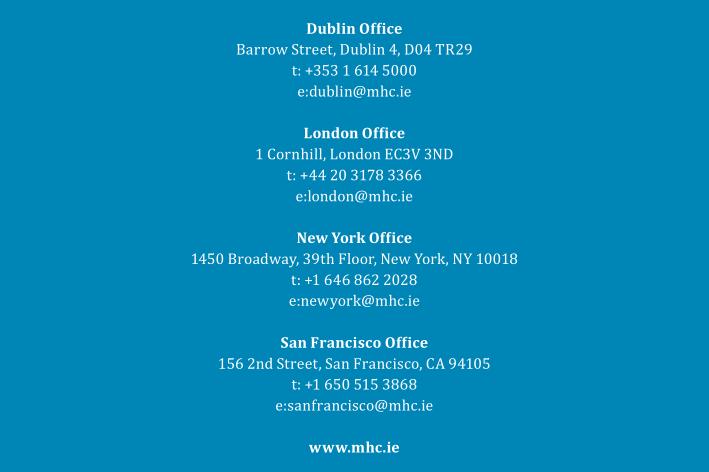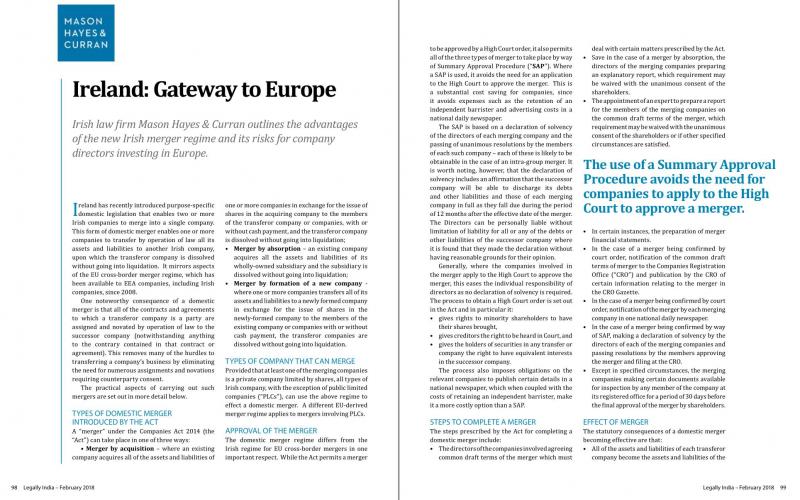Ireland has recently introduced purpose-specific domestic legislation that enables two or more Irish companies to merge into a single company. This form of domestic merger enables one or more companies to transfer by operation of law all its assets and liabilities to another Irish company, upon which the transferor company is dissolved without going into liquidation. It mirrors aspects of the EU cross-border merger regime, which has been available to EEA companies, including Irish companies, since 2008.
One noteworthy consequence of a domestic merger is that all of the contracts and agreements to which a transferor company is a party are assigned and novated by operation of law to the successor company (notwithstanding anything to the contrary contained in that contract or agreement). This removes many of the hurdles to transferring a company’s business by eliminating the need for numerous assignments and novations requiring counterparty consent.
The practical aspects of carrying out such mergers are set out in more detail below.
Types of domestic merger introduced by the Act
A “merger” under the Companies Act 2014 (the “Act”) can take place in one of three ways:
Merger by acquisition – where an existing company acquires all of the assets and liabilities of one or more companies in exchange for the issue of shares in the acquiring company to the members of the transferor company or companies, with or without cash payment, and the transferor company is dissolved without going into liquidation;
Merger by absorption – an existing company acquires all the assets and liabilities of its wholly-owned subsidiary and the subsidiary is dissolved without going into liquidation;
Merger by formation of a new company - where one or more companies transfers all of its assets and liabilities to a newly formed company in exchange for the issue of shares in the newly-formed company to the members of the existing company or companies with or without cash payment, the transferor companies are dissolved without going into liquidation.
Types of company that can merge
Provided that at least one of the merging companies is a private company limited by shares, all types of Irish company, with the exception of public limited companies (“PLCs”), can use the above regime to effect a domestic merger. A different EU-derived merger regime applies to mergers involving PLCs.
Approval of the Merger
The domestic merger regime differs from the Irish regime for EU cross-border mergers in one important respect. While the Act permits a merger to be approved by a High Court order, it also permits all of the three types of merger to take place by way of Summary Approval Procedure (“SAP”). Where a SAP is used, it avoids the need for an application to the High Court to approve the merger. This is a substantial cost saving for companies, since it avoids expenses such as the retention of an independent barrister and advertising costs in a national daily newspaper.
The SAP is based on a declaration of solvency of the directors of each merging company and the passing of unanimous resolutions by the members of each such company – each of these is likely to be obtainable in the case of an intra-group merger. It is worth noting, however, that the declaration of solvency includes an affirmation that the successor company will be able to discharge its debts and other liabilities and those of each merging company in full as they fall due during the period of 12 months after the effective date of the merger. The Directors can be personally liable without limitation of liability for all or any of the debts or other liabilities of the successor company where it is found that they made the declaration without having reasonable grounds for their opinion.
Generally, where the companies involved in the merger apply to the High Court to approve the merger, this eases the individual responsibility of directors as no declaration of solvency is required. The process to obtain a High Court order is set out in the Act and in particular it:
gives rights to minority shareholders to have their shares brought,
gives creditors the right to be heard in Court, and
gives the holders of securities in any transfer or company the right to have equivalent interests in the successor company.
The process also imposes obligations on the relevant companies to publish certain details in a national newspaper, which when coupled with the costs of retaining an independent barrister, make it a more costly option than a SAP.
Steps to complete a merger
The steps prescribed by the Act for completing a domestic merger include:
The directors of the companies involved agreeing common draft terms of the merger which must deal with certain matters prescribed by the Act.
Save in the case of a merger by absorption, the directors of the merging companies preparing an explanatory report, which requirement may be waived with the unanimous consent of the shareholders.
The appointment of an expert to prepare a report for the members of the merging companies on the common draft terms of the merger, which requirement may be waived with the unanimous consent of the shareholders or if other specified circumstances are satisfied.
In certain instances, the preparation of merger financial statements.
In the case of a merger being confirmed by court order, notification of the common draft terms of merger to the Companies Registration Office (“CRO”) and publication by the CRO of certain information relating to the merger in the CRO Gazette.
In the case of a merger being confirmed by court order, notification of the merger by each merging company in one national daily newspaper.
In the case of a merger being confirmed by way of SAP, making a declaration of solvency by the directors of each of the merging companies and passing resolutions by the members approving the merger and filing at the CRO.
Except in specified circumstances, the merging companies making certain documents available for inspection by any member of the company at its registered office for a period of 30 days before the final approval of the merger by shareholders.
Effect of Merger
The statutory consequences of a domestic merger becoming effective are that:
All of the assets and liabilities of each transferor company become the assets and liabilities of the successor company.
The transferor company or companies is or are dissolved.
All legal proceedings pending by or against any transferor company continue with the substitution for each transferor company of the successor company as a party.
In the case of a merger confirmed by the High Court, the Act specifically provides a mechanism by which the successor company can be registered as the successor in title to the transferor company or companies in relevant public registers. There is no equivalent mechanism in the case of confirmation using the SAP.
Tax Considerations
While the Irish tax legislation contains provisions dealing with cross-border mergers, aimed at achieving a tax neutral transfer of assets on the merger where certain conditions are satisfied; to date, no such provisions have been published for domestic mergers between two Irish companies.
A merger involves (i) a transfer of assets and liabilities from one company to another and (ii) a dissolution of the transferor company. These two elements of the merger need to be considered from a tax perspective and each tax head analysed. In essence, the merger is like any transfer of assets under an asset purchase or business transfer agreement.
Depending on the type of merger involved, existing reliefs and exemptions may be of relevance. Below is a high level overview of some of the key tax considerations. There are numerous practical issues that will need to be considered by companies considering mergers.
Relevant tax heads – mergers
Stamp duty
Stamp duty is a tax on documents. It applies to documents which effect the transfer of assets and stamp duty applies at the rate of 1% or 2% depending on the asset involved.
Where the assets transfer by operation of law under a merger, then technically a charge to stamp duty should not arise and the court order (in a court approved merger) or directors’ resolution (in a merger approved by way of the SAP procedure) should not be regarded as stampable instruments.
Negotiations and discussions with Revenue are currently ongoing in relation to the legal effect of the domestic merger and whether a legislative amendment is required.
Capital gains tax
The transfer of a chargeable asset by a transferor to the successor company on any form of merger will constitute a disposal of the asset by the transferor for capital gains tax.
Whether relief is available will depend on the type of merger involved. In a merger by absorption, assets are transferred from a subsidiary to its parent company and ordinarily such a transaction would benefit from group relief. However, as the transfer of assets occurs at the same time as the transfer is dissolved there is some doubt as to whether there is in fact a group transfer. This matter is also being discussed with Revenue.
In a merger by formation of a new company or a merger by acquisition, reconstruction relief may apply as shares are issued in consideration for the acquisition of the assets. A number of technical points are being clarified with Revenue on this point and where applicable, the assets would transfer for their original acquisition cost.
Each of the assets transferring should be reviewed to determine whether any other exemptions apply, for example, in the case of shareholdings being transferred, the substantial shareholding exemption might apply.
The dissolution of the transferor company will involve a disposal by its shareholder. There is an exemption for cross border mergers which apply equally to a domestic merger by absorption where the assets are transferred from a subsidiary to its parent: this is not treated as a disposal by the parent company of the shares in the subsidiary.
Corporation tax
The transfer of a company’s assets and liabilities will be treated as the cessation of the company’s trade. Depending on the date of the transfer, the date for payment of preliminary corporation tax and filing tax returns may be brought forward.
Provided certain conditions are met, there is specific relief in Irish legislation to allow a trading company which ceases its trade and is carried on by another company, to have its unused trading losses used by the successor company against profits of the same trade.
VAT
Transfer of business relief should apply where the transfer of the assets and liabilities amounts to a supply for VAT purposes, provided the successor company is VAT registered.
Payroll taxes
The current practice in the case of a business or asset transfer involving the transfer of employees is for the parties to apply to Revenue to confirm that there is no requirement to issue certificates of cessation (P45s) to the transferring employees. This practice will continue for domestic mergers and employees will have continuity of service.
Conclusion
The domestic mergers regime has already proved a useful addition to Irish corporate law. It benefits groups that wish to reorganise and simplify their structures by, for example, merging and dissolving group companies without the need to put them into liquidation. It enables spin-outs and hive-downs in a manner that is more straightforward than was previously available. We have seen considerable use of this merger process by groups that have Irish companies in their structures.
The particular circumstances in each given case will determine which type of merger is most appropriate and whether a SAP or an application to Court is suitable. The SAP has benefits in a group context, especially where the parties wish to proceed by way of a merger by absorption and where there are no complexities (such as the need to transfer title to real estate). On the other hand, in larger or more complex transactions, the directors may have legitimate reasons not to risk personal liability; in which case, a Court approval merger is more appropriate.
The tax position of domestic mergers is undergoing detailed analysis by practitioners in conjunction with Irish Revenue. It is hoped that this will progress as quickly as possible so that taxpayers can be assured of the correct tax treatment. Until then, the Irish Revenue continues to deal with at least stamp duty and capital gains tax aspects of mergers on a case by case basis.
ABOUT MASON HAYES & CURRAN
Mason Hayes & Curran is one of Ireland’s leading business law firms. We understand the challenges international organisations face when investing or locating in a foreign country. We assist them during initial establishment and in meeting their ongoing legal and commercial imperatives. We have offices in London, New York and San Francisco, three of Ireland’s most important conduits for inward investment to Ireland.
To find out more about how we can help you, please contact the authors or their offices in Dublin, London, New York or San Francisco.
About the authors

Liam Brazil is a partner on our Corporate team and has more than 25 years’ experience in all aspects of company law. His practice is made up of both transactional and advisory work.
On the transactional side, he practices in the areas of private company mergers and acquisitions, corporate structures and re-organisations, joint ventures and shareholder arrangements, foreign direct investment and corporate finance. While Liam has deal experience across many industry sectors, he has established a reputation in the renewable sector and in particular in the sale and purchase of wind farm projects.
On the advisory side, Liam advises a number of our corporate clients on technical company law and corporate governance type matters.
Specialties:
Company Law
Mergers and Acquisitions
Inward Investment
Corporate Structures and Re-organisations
Joint Ventures and Shareholder Arrangements
Recommendations:
Chambers Global, Chambers and Partners, 2015, 2016, 2017.

David Mangan is a partner in our Corporate team and head of the Mason Hayes & Curran New York office, practising in the areas of company law and securities law.
He is also a member of our Capital Markets team and advises listed and unlisted corporate clients on transactions such as mergers and acquisitions, debt and equity offerings, share buybacks, reorganisations, cross-border mergers and financing.
David closely advises a number of listed clients on corporate governance and securities regulation matters, such as compliance with listing rules and relevant codes.
Specialties:
Company Law
Mergers and Acquisitions
Inward Investment
Corporate Structures and Re-organisations
Joint Ventures and Shareholder Arrangements

John Gulliver is head of our Tax team and chairs the firm’s International Committee. For more than 25 years he has advised Fortune 500, FTSE 100 and other major multi-nationals in respect of international tax.
He has a particular focus on advising multinationals in respect of using an Irish corporate footprint as part of an acceptable international tax strategy in the post-BEPS environment.
Chambers Europe noted that “John is like a walking textbook when it comes to the international tax space” and that he has the “ability to identify the problems and solve them before they arise.”
Specialties:
Tax
Recommendations:
Chambers Europe, Chambers and Partners, 2015, 2016, 2017; The Legal 500, 2015.

Maura Dineen is a partner in our Taxation team. She advises a wide range of clients in the pharmaceuticals, technology and real estate sectors.
She has significant experience in advising domestic and international clients on a wide range of tax matters including inward investment, corporate restructurings, mergers and acquisitions, intellectual property exploitation and tax-efficient financing structures. Maura regularly advises clients on tax efficient financing and structuring of property acquisitions. She also advises on stamp duty and VAT matters.
Maura was the national reporter for Ireland on the Tax Committee of the International Bar Association for 2016 and 2015. She is a member of the Law Society Tax Committee and one of their representatives on the joint Revenue committee for direct taxes.
Specialties:
Tax
Mergers & Acquisitions
Inward Investment
Company Restructurings
Real Estate Taxation
Recommendations:
Chambers Europe, Chambers and Partners, 2016, 2017.


Welcome Legally India's Spring 2018 Issue
If you would like to receive future editions, please click here to register your interest.
Our Spring 2018 print and digital edition of Legally India, a joint publication by Global Legal Media and Legally India, has a strong disputes flavour, and examines: AI, global litigation risk, GC wishlists and more than a dozen jurisdictions and practice areas.
